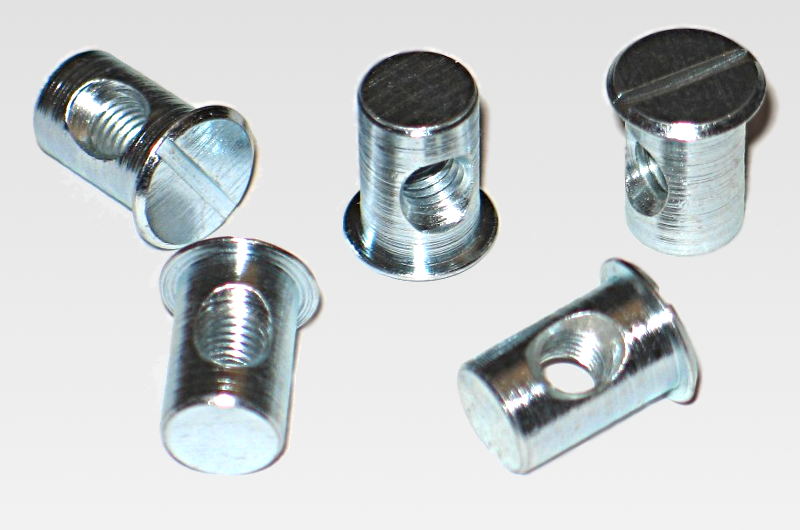Router Table Fence
With Micro-Adjustment
This page will give a design and construction overview of my pivoting router table fence with micro-adjustment capabilities.
The pivoting design is simple and sturdy. It won't bind as it moves and therefore removes the need for tracks, guides or other means of keeping it square. The fence can be constructed mostly from scrap materials, if desired. The cost for materials is low (about $10-$20). It's easy to build with common tools. My fence configuration can produce adjustments of 0.015" with half a turn of the threaded rod. Altering the design can easily produce adjustments of 0.0085" with half a turn.

Basic router table fence design

Router table fence
Design Overview
One end of the fence will pivot. The other end is connected to a stationary post by a length of threaded rod. As the threaded rod is turned, it will pull or push the fence. By varying the thread pitch of the threaded rod and the rod's distance from the pivot point relative to the router bit, a range of adjustments can be achieved. The threaded rod can hold the fence in place, but the addition of a clamp will reduce stress on the rod and associated parts while doing a better job of holding the fence.
I won't provide a complete set of specific dimensions or specifications because they aren't necessary. The dimensions, materials and layout can be varied to suit your particular needs.

Router table fence
Construction
The threaded rod is run through two posts - one on the fence and one connected to the router table. The rod is allowed to turn freely in the post connected to the fence. Nylon lock nuts and washers (not shown in the images) on each side of the post prevent the threaded rod from moving in or out. The post mounted to the router table is threaded so it functions as a large nut.

Router table posts and threaded rod

Router table posts and threaded rod
As seen in the image below, both of the posts must be allowed to pivot as the screw turns to prevent binding.

Pivoting table posts

Pivoting table posts
The posts are made of solid wood cubes (sorry about the particle board texture in the images) measuring 0.75". First, a 3/8" hole was drilled through them vertically and a wood dowel was glued in. Next, a hole was drilled in horizontally to accept the threaded rod. I used 1/4" 20 tpi rod. One hole was drilled slightly larger than 1/4" to allow the rod to rotate freely (this post is connected to the fence). The other post was drilled slightly smaller than 1/4" and threads were tapped in (this post is mounted to the router table).

Table posts
Next time I will consider using cross dowel nuts or barrel nuts (shown below) assuming I can find them long enough so they can be held in place. They're often used in wood handscrew clamps.

Cross dowel nuts or barrel nuts
A saddle was built for each post to hold it in place. The saddles are bolted down with #10 machine screws. The posts need some space around them so they can turn and pivot. A small amount of vertical space will help them pivot freely. I added a little wax to the vertical dowels to help the posts pivot. A toggle clamp was added to hold the fence in place. The threaded rod will hold the fence in place, but adding stress to it may not be good for it. The fence pivots on a 3/8" bolt. A small knob was added to the end of the threaded rod. My fence is about 4" high, which seems to be nice height for the work I've done.
I routed a rabbet in the fence to give it a little bit more stability. My fence was made with MDF and plywood because those were the scrap pieces I had available.

Fence rabbet
Next time I may add a knob to tighten down the fence in place of (or possibly along with) the toggle clamp. The knob would require a curved slot to be routed into the table.

Knob to tighten the fence
Micro-Adjustments
The amount of micro-adjustment will depend on the thread pitch of the threaded rod and the rod's distance from the pivot point relative to the router bit. In my case, I used a thread pitch of 20 tpi (threads per inch). Each turn will move the rod 1/20th of an inch (0.05"). However, the rod is positioned about 1.6 times further from the pivot point than the router bit. So for every 1" the rod moves, the fence will move 0.6" at the router bit (1 / 1.6 = 0.6). Therefore, each turn of my rod will move the fence 0.03" at the router bit (0.05" x 0.6 = 0.03"). I can turn the rod half a turn for 0.015" adjustments. If I happen to feel the need to set unrealistically demanding goals accompanied by a disposition to regard failure to achieve them as unacceptable and a sign of personal worthlessness - then I can use 1/4 turns for 0.0075" adjustments.
Use the following calculator to calculate the adjustment distance for each turn of your threaded rod:
Contact Me
You may contact me at kevin@kevinsworkbench.com